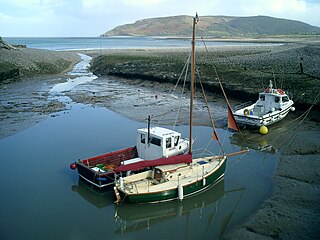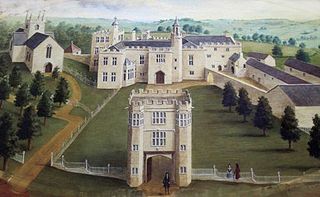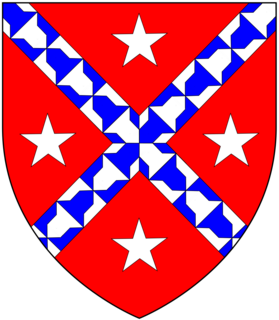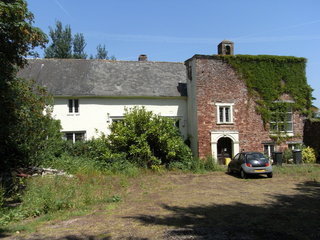
Thomas Grey, 1st Marquess of Dorset, 1st Earl of Huntingdon, 7th Baron Ferrers of Groby, was an English nobleman, courtier and the eldest son of Elizabeth Woodville and her first husband Sir John Grey of Groby. Her second marriage to King Edward IV made her Queen of England, thus elevating Grey's status at court and in the realm as the stepson of the King. Through his mother's assiduous endeavours, he made two materially advantageous marriages to wealthy heiresses, the King's niece Anne Holland and Cecily Bonville, 7th Baroness Harington. By the latter he had 14 children.

Porlock is a coastal village in Somerset, England, 5 miles (8 km) west of Minehead. It has a population of 1,440.

Walter Hungerford, 1st Baron Hungerford was an English knight and landowner, from 1400 to 1414 a Member of the House of Commons, of which he became Speaker, then was an Admiral and peer.

Old Shute House, located at Shute, near Colyton, Axminster, Devon, is the remnant of a mediaeval manor house with Tudor additions, today in the ownership of the National Trust. It was given a Grade I listing on 14 December 1955. It is one of the most important non-fortified manor houses of the Middle Ages still in existence. It was built about 1380 as a hall house and was greatly expanded in the late 16th century and partly demolished in 1785. The original 14th-century house survives, although much altered. This article is based on the work of Bridie (1955), which has however been superseded as the standard work of reference on the architectural history of the building by the unpublished Exeter Archaeology Report of 2008 produced for the National Trust. This report draws on new evidence gained from the recently discovered survey of 1559 made by Sir William Petre, which lists each main room of the then existing house together with its contents. From this evidence a conjectural ground plan of the house pre-1785 was recently produced by Roger Waterhouse.

A church monument is an architectural or sculptural memorial to a deceased person or persons, located within a Christian church. It can take various forms ranging from a simple commemorative plaque or mural tablet affixed to a wall, to a large and elaborate structure, on the ground or as a mural monument, which may include an effigy of the deceased person and other figures of familial, heraldic or symbolic nature. It is usually placed immediately above or close to the actual burial vault or grave, although very occasionally the tomb is constructed within it. Sometimes the monument is a cenotaph, commemorating a person buried at another location.

Baron Harington, of Aldingham, was a title in the Peerage of England. On 30 December 1324 John Harington was summoned to parliament. On the death of the 5th baron in 1458, the barony was inherited by the heir to the barony of Bonville, with which title it merged in 1461, until both baronies were forfeited in 1554.

Dubricius or Dubric was a 6th-century British ecclesiastic venerated as a saint. He was the evangelist of Ergyng and much of southeast Wales.

Thomas Grey, 2nd Marquess of Dorset was an English peer, courtier, soldier, and landowner.

Knowstone is a village and civil parish situated in the North Devon district of Devon, England, halfway between the Mid Devon town of Tiverton, Devon and the North Devon town of South Molton. The hamlet of East Knowstone lies due east of the village. Knowstone was the birthplace of Admiral Sir John Berry (1635–1691), second son of Rev. Daniel Berry (1609–1654), vicar of Knowstone cum Molland. An elaborate mural monument erected by Sir John in 1684 to the memory of his parents survives in Molland Church.

William Bonville, 6th Baron Harington was an English nobleman who was a loyal adherent of the House of York during the dynastic conflict in England in the 15th century now known as the Wars of the Roses. He was slain and left dead on the field during the Yorkist defeat at the Battle of Wakefield, leaving his baby daughter, Cecily Bonville heiress to his barony.

Thomas de Courtenay, 5th/13th Earl of Devon was a nobleman from South West England. His seat was at Colcombe Castle near Colyton, and later at the principal historic family seat of Tiverton Castle, after his mother's death. The Courtenay family had historically been an important one in the region, and the dominant force in the counties of Devon and Cornwall. However, the rise in power and influence of several gentry families and other political players, in the years leading up to Thomas' accession to the earldom, threatened the traditional dominance of the earls of Devon in the area. Much of his life was spent in armed territorial struggle against his near-neighbour, Sir William Bonville of Shute, at a time when central control over the provinces was weak. This feud forms part of the breakdown in law and order in England that led to the Wars of the Roses.

Hugh de Courtenay, 4th/12th Earl of Devon was an English nobleman, son of the 3rd/11th Earl of Devon, and father of the 5th/13th Earl. The ordinal number given to the early Courtenay Earls of Devon depends on whether the earldom is deemed a new creation by the letters patent granted 22 February 1334/5 or whether it is deemed a restitution of the old dignity of the de Redvers family. Authorities differ in their opinions, and thus alternative ordinal numbers exist, given here.
Margaret Grey was a Cambro-Norman noblewoman, the daughter of Reginald Grey, 3rd Baron Grey de Ruthyn, a powerful Welsh Marcher Lord, who was the implacable enemy of Owain Glyndŵr.

Laughton is a village and a civil parish in the West Lindsey district of Lincolnshire, England. The population of the civil parish at the 2011 census was 410. It is situated approximately 6 miles (10 km) north from the town of Gainsborough

Sir Neil Loring, KG, was a medieval English soldier and diplomat and a founding member of the Order of the Garter, established by King Edward III in 1348. The central character in two historical novels by Sir Arthur Conan Doyle, Sir Nigel and The White Company, is loosely based on Neil Loring.

John Harington, 4th Baron Harington was an English nobleman who inherited the title of Baron Harington of Aldingham in Furness, Lancashire. He was the son of Robert Harington, 3rd Baron Harington and Isabella Loring, daughter and co-heiress of Sir Neil Loring.

The manor of Wadham in the parish of Knowstone in north Devon and the nearby manors of Chenudestane and Chenuestan are listed in the Domesday Book of 1086:

Great Fulford is an historic estate in the parish of Dunsford, Devon. The grade I listed manor house, known as Great Fulford House, is about 9 miles west of Exeter. Its site was said in 1810 to be "probably the most ancient in the county". The present mansion house is Tudor with refurbishment from the late 17th century and further remodelling from about 1800. The prefix "Great" dates from the late 17th century and served to distinguish it from the mansion house known as "Little Fulford" in the parish of Shobrooke, Devon, about 8 miles to the north-east, also owned briefly by Col. Francis Fulford (1666–1700), as a result of his marriage to the heiress of the Tuckfield family. Great Fulford has been the residence of the Fulford family, which took its name from the estate, from the reign of King Richard I (1189–1199) to the present day. There are thus few, if any, families in Devonshire of more ancient recorded origin still resident at their original seat. In 2004 the estate comprised 3,000 acres.

Sir John Hill of Kytton in the parish of Holcombe Rogus, and of Hill's Court in the parish of St Sidwell in the City of Exeter, both in Devon, was a Justice of the King's Bench from 1389 to 1407.

Blagdon historically in the parish of Paignton in Devon, England, is an historic manor, the seat of the Kirkham family from the 13th to 17th centuries. The manor house known as Blagdon Manor (House) survives as a grade II* listed building about two miles west of the historic centre of the town of Paignton, situated behind the "Blagdon Inn" public house, and almost surrounded by the "Devon Hills Holiday Park" of caravans and mobile homes, set-back at the end of a short driveway off the A385 Paignton to Totnes road. The settlements or farms of Higher Blagdon, Middle Blagdon and Lower Blagdon are situated to the north of the manor house.























